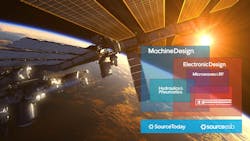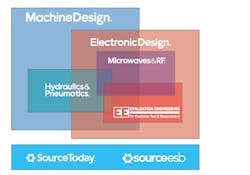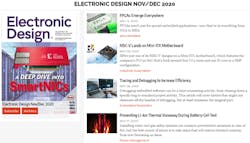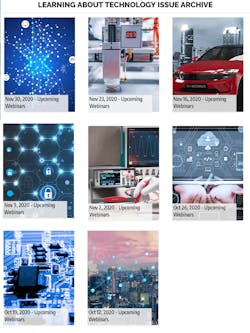Understanding Electronic Design and Its Peers
This article appeared in Electronic Design and has been published here with permission.
What you’ll learn
- Areas covered by our publications.
- How their coverage overlaps.
- Where do our articles come from?
I started working at Electronic Design as a Technology Editor at the start of the millennium when the International Space Station (ISS) had its first visitors and the millennium bug was rampant—or not. That was in 2000. These days, I’m the Editor for Electronic Design as well as the Senior Content Director, where I manage Electronic Design, Evaluation Engineering, and Microwaves & RF. Alix Paultre is the Editor of Evaluation Engineering. David Maliniak is Editor for Microwaves & RF.
We are all part of the Endeavor Business Media’s Design & Engineering Group that also includes Machine Design, Hydraulics & Pneumatics, Source Today, and SourceESB.
Our publications are horizontal in nature that cover a wide range of topics, hence the overlap, although some focus on specific areas like hydraulics and wireless technology. We provide readers with an encompassing perspective, addressing markets from automotive to Industry 4.0. This is a high-level partitioning of the topic areas of each publication:
- Electronic Design – electronic hardware and embedded software
- Evaluation Engineering – test and measurement
- Hydraulics & Pneumatics – the name says it all, but another way to say it is fluid power
- Machine Design – mechanical and process control
- Microwave & RF – radio and wireless technology
- SourceESB – components availability
- SourceToday – distribution and procurement
This diagram provides a crude approximation of the content overlap of our publications and websites (Fig. 1). It’s not to scale in any fashion, and the section at the bottom that comprises SourceToday and SourceESB actually indicates that they support all of the editorial brands.
So, is this article just a big advertisement?
The challenge for readers and even advertisers is that their areas of interest tend to span our sites. Managers, developers, and engineers—many of whom wear multiple hats these days—would be interested in a range of our publications, although they may identify with one particular publication. For example, mechanical engineers will gravitate to Machine Design over Electronic Design, while electrical engineers will likely favor the reverse. Both cover topics like robotics and industrial automation, but with slightly different emphasis.
Methods of Consumption
Websites tend to be the way most people read articles today, but our publications are some of the few that still deliver print issues. The issues are smaller than in our heyday, and it can still be hard to get on the mailing list. They cover a subset of what’s online but offer a handy way to check out some of the best of the online content. Plus our digital archives contain PDF copies of our print editions (Fig. 2).
We also have digital magazines, where you can see more of our online content instead of just reading one article and bouncing off to another site (Fig. 3).
Of course, these days the written word isn’t the only type of content engineers and programmers are interested in, so we also collect our webinars into what’s called the Learning About Technology series. The Learning About Technology digital magazine highlights the latest and upcoming webinars (Fig. 4).
We also understand that one article can never cover all of the details. We bring together multiple articles on the same topic, such as SmartNICs and cryptography. Many of these are ongoing series, like Jon Peddie’s Graphics Chip Chronicles that covers the history of graphics processors one chip at a time, starting with the venerable NEC µPD7220 Graphics Display Controller: The first graphics processor chip. Many of these series are available as a PDF ebook download.
Brand Coverage and Target Audiences
A more detailed coverage discussion will be useful to many as presented here by brand. Content from brands like Hydraulics & Pneumatics and Evaluation Engineering tends to be more focused than their counterparts. All brands target designers, engineers, programmers, and CTOs, essentially professionals dealing with the respective technology areas.
Electronic Design covers the electronics industry from chips through systems and the cloud. This includes tools and software such as operating systems, development tools, and lifecycle management solutions. This is a broad scope that also offers, for example, wireless technologies covered in more detail by Microwaves &RF as well as test and measurement areas addressed by Evaluation Engineering. Electronic Design and Machine Design have quite a bit of overlap when it comes to markets such as automotive and manufacturing, as well as topic areas like IoT and rapid prototyping that involve technologies ranging from IoT measurements to 3D-printed prototypes.
Evaluation Engineering targets the test and measurement engineering market, addressing all aspects of electronic and mechanical design. This includes test and measurement equipment for areas such as semiconductors, medical, communication, RF, microwave, and wireless applications. Cross-posted articles from Evaluation Engineering usually target Electronic Design and Microwaves & RF.
Hydraulics & Pneumatics (H&P) sets its sights on design engineers, manufacturing engineers, and other technical personnel involved in designing, buying, or specifying fluid-power components, hydraulics, and pneumatics. Hydraulics and pneumatics technologies are widely used across the world in diverse industries ranging from food processing and medical equipment to construction, mining, and offshore energy. H&P often meshes with our electronic publications when it comes to measurement and IoT.
Machine Design is the comprehensive technical resource for mechanical engineers, providing the technical essentials of advanced design and manufacturing. It covers traditional and revolutionary topics that are critical to design and manufacturing advancement, from bearings to motors, motion control to IoT, and everything in between. Hydraulics and pneumatics are just a few of the topics covered in Machine Design.
Microwave & RF focuses on communications and wireless technologies, including high-frequency electronic design. It also addresses rugged computing, especially for topics like software-defined radio and areas such as military and avionics. It meshes with Evaluation Engineering when it comes to wireless and radio test and measurement technologies, and with Electronic Design on topics like IoT communication.
SourceESB isn’t a conventional content publication platform like our other sites. It’s a searchable electronic parts database designed to link those procuring electronic components with companies and distributors that supply these components. It’s integrated with our websites to deliver these services in the context of articles that provide insight and technical information about components.
SourceToday targets engineers, developers, and procurement professionals who need essential news, information, and analysis regarding technology and business trends that impact their global supply chains. SourceToday covers everything from component suppliers and distributors to original design manufacturers and electronic manufacturing services. It also provides insights to strategic issues of critical importance to CPOs, such as the implications of new technologies like IoT, artificial intelligence, and 5G as they impact management of the supply chain. It can draw on the technical content and expertise of all our publications.
Reader Feedback
There are two ways to let the editors and other readers know about what you think of our content. The first is the comment section after each article. This tends to be most useful for feedback to the author or readers about a particular article. Secondly, you can email us directly at [email protected]. We try to respond to each email, but it may take a while depending on how full our inbox is at that given time.
One thing you can bypass our editors on is when changes need to be made to newsletter, online, or digital subscriptions. Our Subscription Management page has all of the details and links. Occasionally, we conduct surveys to gain insights into the industry and our audience. Our annual salary survey is emailed to subscribers each year. You can check out the results and our analysis as well as looking at archived reports.
Article Sources and Contributions
When I started with Electronic Design, a significant portion of the magazine was written by technology editors like myself. We did and still have a lot of regular content from contributors, such as in our Ideas for Design and Design Solutions sections, which we’re still doing.
Back at the turn of the century, the staff was larger. However, times have changed, and staffs have been slimmed down. On the other hand, we’re actually publishing more content online because we don’t have the limitations of a print publication. It’s also easier to present, as well as read, multipart series—something that wasn’t possible in print, where you would have to collect the articles manually. Thus, we’re always looking for new technically oriented content.
To make things easier to contribute, we’ve put together an extensive contributor packet that can be downloaded from our “Contribute” page. It covers everything, such as our article styles like the 11 Myths and What’s the Difference that are tailored to engineers and programmers who don’t put technical writing high on their list of favorite things to do. Don’t forget that we need a signed release form, because we only publish content exclusive to us and need your permission to post it.
We really like our contributed content. The more technical the better, as our readers have the background and interest to understand the details.
Sales and Marketing
There’s no charge for having us post a contributed article, but we do ask that they are generic in nature. Not everything submitted gets published.
Contributed articles can mention company products or services, but they should serve as examples in the article, not as detailed descriptions of features, etc. Still, you will see sponsored articles on our site that do drill down into the details of products and services.
We have a pretty good boundary between church and state (i.e., editorial and sales), so I will just direct anyone who is interested to our marketing and solutions website. That has all of the details and contacts for sponsored content and other services like hosting webinars.
You don’t have to submit sponsored content or general contributed content exclusively. It’s possible to do both, although not in the same article. Content like webinars tends to be sponsored, though. If you’re planning on addressing a particular topic area, a series of contributed articles isn’t a bad idea.
Press Releases
This is a follow on to the sales aspect of our discussion. We don’t post press releases verbatim like many other sites. We do make use of them for our products of the week, as well as a means of keeping track of what’s going on in case our technology editors need to contact you about a new product. You can send press releases to [email protected].
We send you an email note if we include information in an article, but we use only a fraction of what we receive. In addition, we’re only looking for product and technology announcements. News such as personnel promotions or business reconfigurations aren’t commonly used.
Wrapping Up
If you made it this far, you’re doing pretty good. I hope this article has presented a useful overview of our sites and the content you can find on a regular basis. You can browse the site as usual, subscribe to the newsletters and digital and print editions, and check out our other resources in indexes.
If you’re a reader, then enjoy. If you want to contribute, we look forward to hearing from you. If you want to take advantage of our site and services, we can help.
Thanks for reading.
About the Author
William G. Wong
Senior Content Director
I am Editor of Electronic Design focusing on embedded, software, and systems. As Senior Content Director, I also manage Microwaves & RF and I work with a great team of editors to provide engineers, programmers, developers and technical managers with interesting and useful articles and videos on a regular basis. Check out our free newsletters to see the latest content.>
You can send press releases for new products for possible coverage on the website. I am also interested in receiving contributed articles for publishing on our website. Use our template and send to me along with a signed release form.
Check out my blog, AltEmbedded on Electronic Design, as well as his latest articles on this site that are listed below.
You can my social media via these links:
- AltEmbedded on Electronic Design
- Bill Wong on Facebook
- @AltEmbedded on Twitter
- Bill Wong on LinkedIn
I earned a Bachelor of Electrical Engineering at the Georgia Institute of Technology and a Masters in Computer Science from Rutgers University. I still do a bit of programming using everything from C and C++ to Rust and Ada/SPARK. I do a bit of PHP programming for Drupal websites. I have posted a few Drupal modules.
I still get a hand on software and electronic hardware. Some of this can be found on our Kit Close-Up video series. You can also see me on many of our TechXchange Talk videos. I am interested in a range of projects from robotics to artificial intelligence.





